Statistical Measures
The following table gives an overview of the available statistical
measures. In column Calculation a hint is given, how the measuere is
calculated from the basic data rows.
| Name |
Abbr. |
Calculation |
| Lower range limit (human estimate) |
- |
x1..xn
sorted list: x1 |
| Upper range limit (human estimate) |
+ |
x1..xn
sorted list: xn |
| Central or typical value (human estimate) |
centr. |
x1..xn
sorted list: xn/2 |
| Lower range limit (legacy data stat. meth.
unknown) |
-(?) |
x1..xn
sorted list: x1 |
| Upper range limit (legacy data stat. meth.
unknown) |
+(?) |
x1..xn
sorted list: xn |
| Central or typical value (legacy data stat. meth.
unknown) |
centr.(?) |
x1..xn
sorted list: xn/2 |
| Minimum value |
Min |
Absolute smallest value |
| Maximum value |
Max |
Absolute largest value |
| Mean (= average) |
μ |
μ=(1/n)∑(n)xi |
| Harmonic mean |
hμ |
hμ=n/(∑(n)(1/xi))
hμ=0 if any xi=0 |
| Geometric mean |
gμ |
gμ=n√∏(n)xi |
| Mode |
mode |
Value that appears most often (ambigious!) |
| Median |
med. |
x1..xn
sorted list
n odd: med=x(n+1)/2
n even:
med=(xn/2+x(n/2+1))/2 |
| Interquartile mean (= average) |
IQM |
x1..xn
sorted list
IQM=μ(x0.25n+1..x0.75n+1) |
| Variance (sample df = n-1) |
Var. |
Sn-1=(1/n-1)∑(n)(xi-μ)2 |
| Variance (population; df = n; rarely
applicable!) |
Var. (pop.) |
Sn=(1/n)∑(n)(xi-μ)2 |
| Standard deviation (sample) |
s.d. |
σn-1=√Sn-1 |
| Standard deviation (population; df = n; rarely
applicable!) |
s.d. (pop.) |
σn=√Sn |
| Mean deviation |
m.d. |
md=(1/n)∑(n)|xi-μ| |
| Mean deviation from median |
m.d.m. |
mdm=(1/n)∑(n)|xi-med| |
| Coefficient of variation (sample) |
CV |
CV=σn/μ |
| Corrected coefficient of variation (sample) |
CVC |
CVC=σn-1/μ |
| Total range |
TR |
x1..xn
sorted list
TR=xn-x1 |
| Interquartile range |
IQR |
x1..xn
sorted list
IQR=x0.75n+1-x0.25n+1 |
| Standard error of mean |
s.e. |
σx=σn-1/√n |
| Standard error of variance (of multiple
samples) |
s.e.(var.) |
Sx=Sn-1/n |
| Skewness |
Skw. |
ϒ1=(1/n)∑(n)((xi-μ)/σ)3 |
| Kurtosis |
Kurt. |
Kurt=(1/n)∑(n)((xi-μ)/σ)4 |
| Sample size |
n |
Number of values |
Adjust display sequence
You may adjust the display sequence of the statistical measures for the
whole database. Choose Administation
->  Database ->
Database ->
 Statistical
measures … from the menu. A window will open as shown below.
Statistical
measures … from the menu. A window will open as shown below.
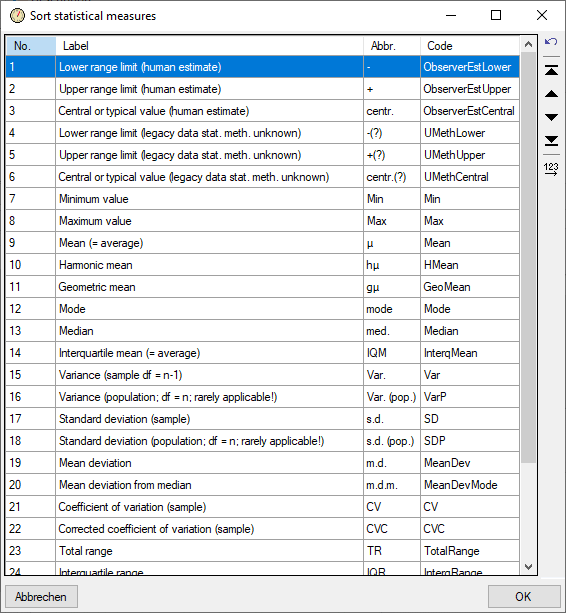
The sequence number column (“No.”) determines the display sequence in
various forms. You may order the entries by clicking on a column header.
With the arrow buttons ( ) you can move the selected entries up or down
within the table, clicking button or shifts the selected entries to the
top respective bottom of the table. After ordering the entries click
button to renumber the table entries (starting with “1” for the first
table entry) and make the changes effective. To save the changes in the
database, leave the form with the OK button, to discard all changes
click the Abort button.
Summarize Descriptions
Summarize description data
With this form you can summarize the information of selected
descriptions and store the summarized data in a new description or
update an existing one. After connecting a database select Edit ->
 Summarize descriptions … from the menu.
Summarize descriptions … from the menu.
Description selection
In the first tab Description selection you search for the
source descriptions that shall be summarized into a new or an
existing target description (see image below).
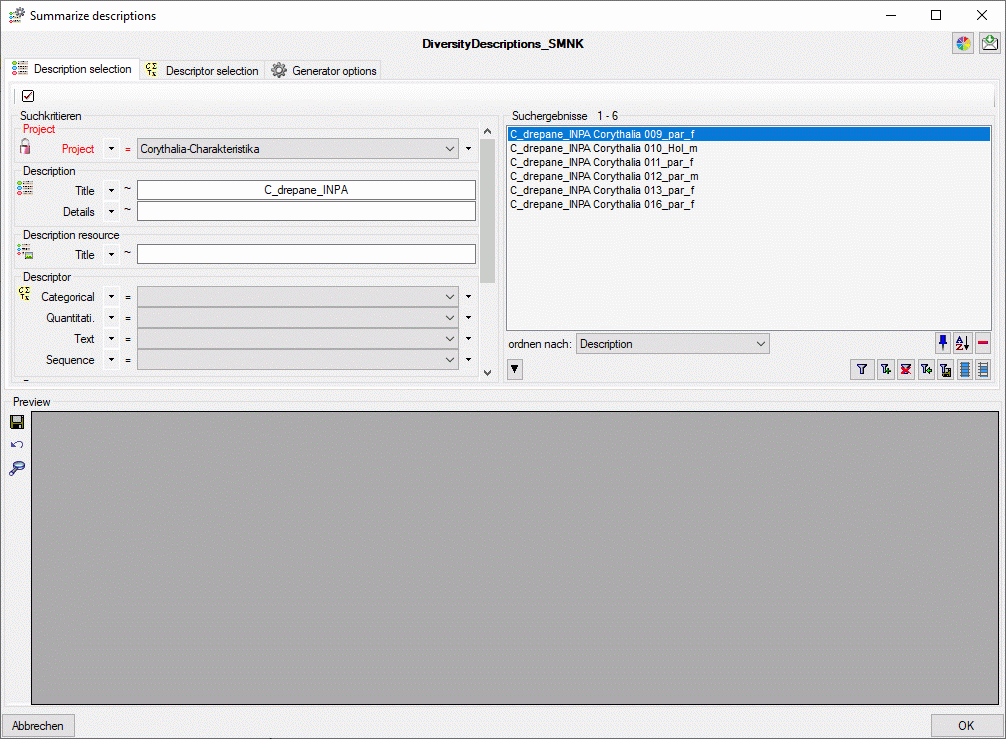
You have to select at least the mandatory parameter Project and
start a query with button  . From the result list
superfluous entries may be removed with the
. From the result list
superfluous entries may be removed with the  button. For a detailled description of the query control please refer to
section Query.
?class=inlineimg
button. For a detailled description of the query control please refer to
section Query.
?class=inlineimg
Descriptor selection
In tab Descriptor selection select the descriptors that shall be
summarized in table column OK (see image below). You can select rsp.
deselect all descriptors with buttons  and
and
 . Button
. Button  inverts
all selections. To select all categorical, quantitative, text or
sequence descriptors the buttons
inverts
all selections. To select all categorical, quantitative, text or
sequence descriptors the buttons  ,
,
 ,
,  and
and
 are avaiable. With button
are avaiable. With button
 you may select a descriptor tree rsp.
descriptor tree node to select all descriptors assigned to the selected
element.
you may select a descriptor tree rsp.
descriptor tree node to select all descriptors assigned to the selected
element.
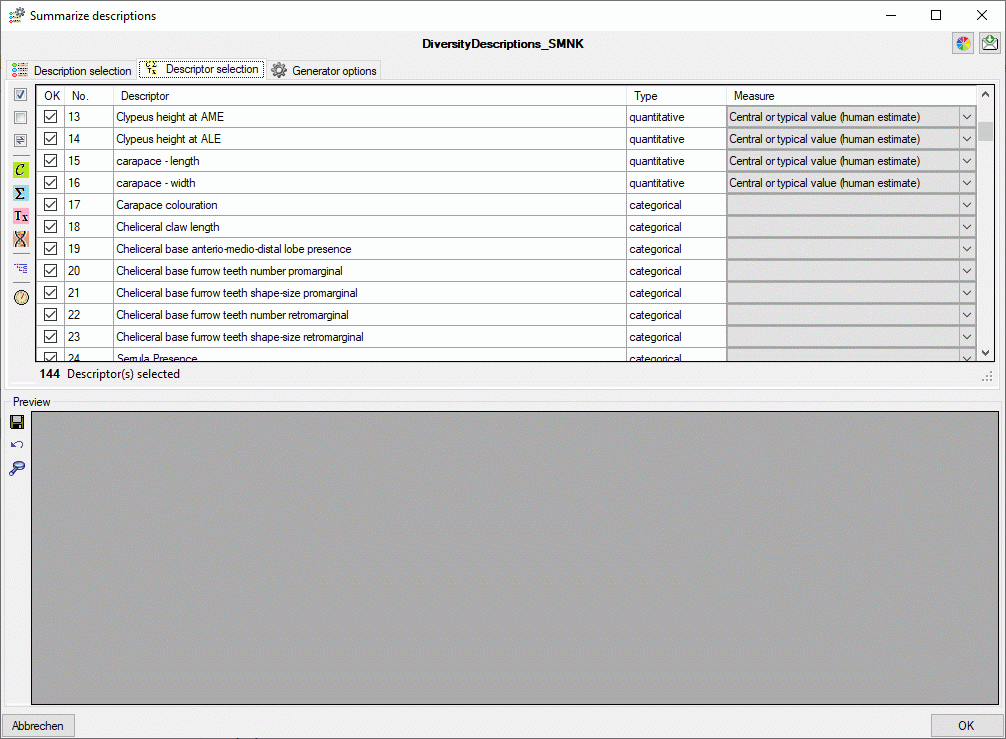
For quantitative descriptors a statistical measure must be specified
where the values for summarization are available. When the descriptor
table is filled, for each quantitative descriptor the available
recommended measures are checked if one of the measures “Mean (=
average)”, “Central or typical value (human estimate)”, “Central or
typical value (legacy data stat. meth. unknown)”, “Mode” or “Sample
size” is available (priority in this sequence), it is pre-selected in
colum Measure. You may modify this adjustment for each single
descriptor or use button  to change the setting
for all selected descriptors.
to change the setting
for all selected descriptors.
Generator options
In section Summarize options you may specify to Ignore notes and
to Ignore modfier values of the source descriptions. If you select
Restrict exclusive descriptors, the most often selected categorical
state of a “exclusive” descriptor will be set instead of accumulating
all source values. Accumulate scopes will collect all scope values,
Accumulate resources all resources of the source descriptions to the
target. Write item count will enter notes containing information
about the number of collected items in the summary data. If you
additionally select Write detailled notes, the source description
IDs will be listed in the notes. Finally, Write summary infomation
inserts a summary about summarized descriptions into the target
description details (see image below).
In section Target description you may select the Target project
(usually the same as the source description’s). You may either create a
New description and enter the description name or Update a
description selected form a drop-down list.
In section Status data you may control the summarization behaviour
for every descriptor data status value:
- Ignore
If in a summarized description the corresponding data status is
present for a descriptor value, it will be summarized but the
descriptor data status will not be set in the target description.
- Summarize
As for Ignore the descriptor values will be summarized. Additionally
the descriptor data status will be set in the target description.
- Omit data
If in a summarized description the corresponding data status is
present for a descriptor value, it will not be summarized and the
descriptor data status will not be set in the target description.
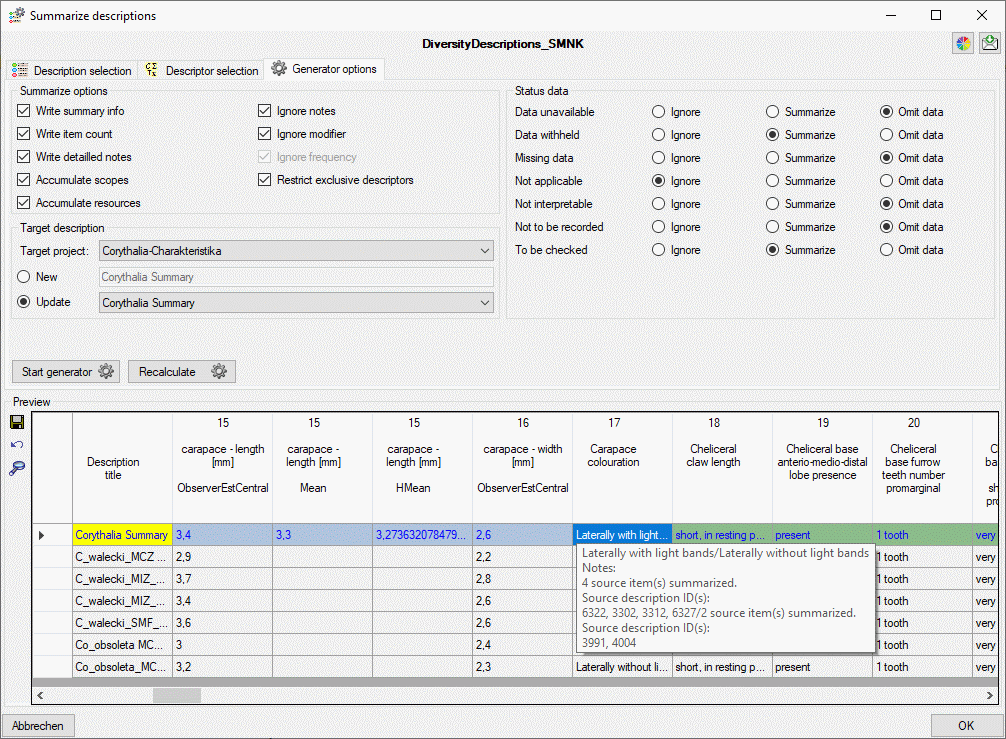
After checking the settings click in button Start generator
 . During processing the icon of the
button changes to
. During processing the icon of the
button changes to  and you may abort by clicking the
button. In the Preview area a table with the generated rsp. updated
target description (coloured background, may be change with button
and you may abort by clicking the
button. In the Preview area a table with the generated rsp. updated
target description (coloured background, may be change with button
 ) and the summarized source descriptions (grey
background) is shown. If the target description has been modified, this
is indicated ba a yellow background of the
description title (see image above). Updated values are shown as blue text. By double-clicking on a field in the
preview table you may view the contents in a separate browser window. To
save the updated values and close the window click the OK button. To
exit without saving click Abort. In this case you will be asked if
you want to save modified data.
) and the summarized source descriptions (grey
background) is shown. If the target description has been modified, this
is indicated ba a yellow background of the
description title (see image above). Updated values are shown as blue text. By double-clicking on a field in the
preview table you may view the contents in a separate browser window. To
save the updated values and close the window click the OK button. To
exit without saving click Abort. In this case you will be asked if
you want to save modified data.
Since building the preview table may take some time, especially if a lot
of descriptors have been selected, you may use the button Recalculate
 for restarting the summary process. In
this case the descriptor columns will not be re-built, only the summary
data will be calculated and actualized. This feature may be useful, if
you change some settings an want to update the data. If you use the
Recalculate
for restarting the summary process. In
this case the descriptor columns will not be re-built, only the summary
data will be calculated and actualized. This feature may be useful, if
you change some settings an want to update the data. If you use the
Recalculate  button with an empty
preview table, only the description titles will be displayed. Anyway you
can view the summarized data using the
button with an empty
preview table, only the description titles will be displayed. Anyway you
can view the summarized data using the  button (see
below).
button (see
below).
You may store all changed entries by clicking the  button or omit all changes and reload the data by clicking the
button or omit all changes and reload the data by clicking the
 button. To view the description details of the
currently selected entry click the
button. To view the description details of the
currently selected entry click the  button and a
separate browser window opens (see image below).
button and a
separate browser window opens (see image below).
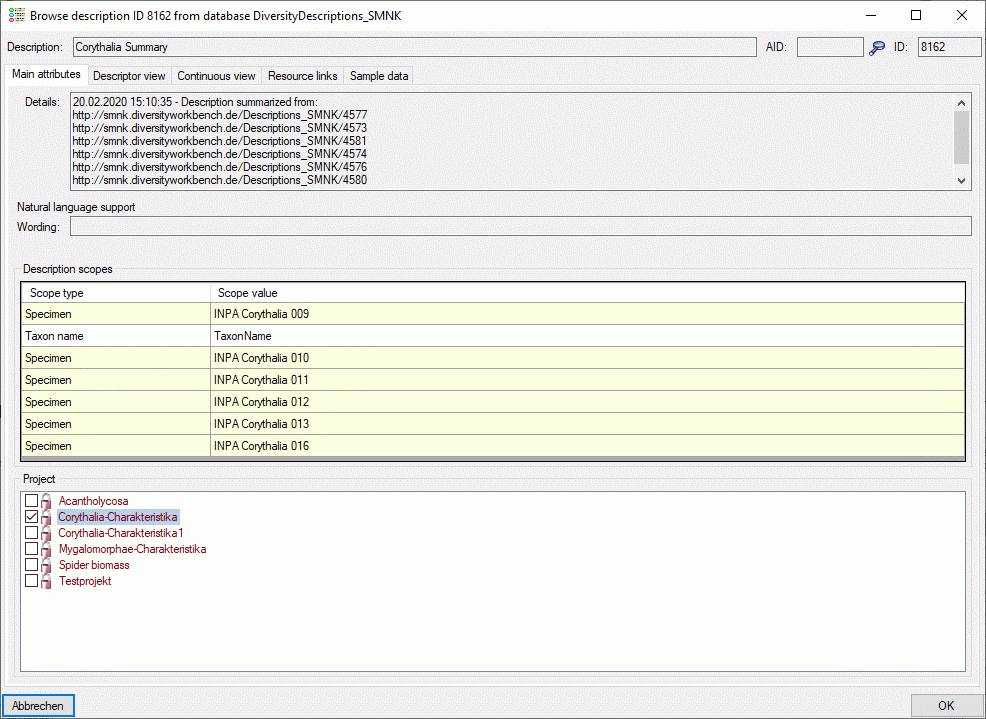
Summarize Sampling Data
With this form you can summarize the information of selected
descriptions and store the summarized data in a new description or
update an existing one. After connecting a database select Edit ->
 Summarize sample data … from the menu.
Summarize sample data … from the menu.
Description selection
In the first tab Description selection you search for the
desriptions that shall be updated by their summarized sample data
(see image below).
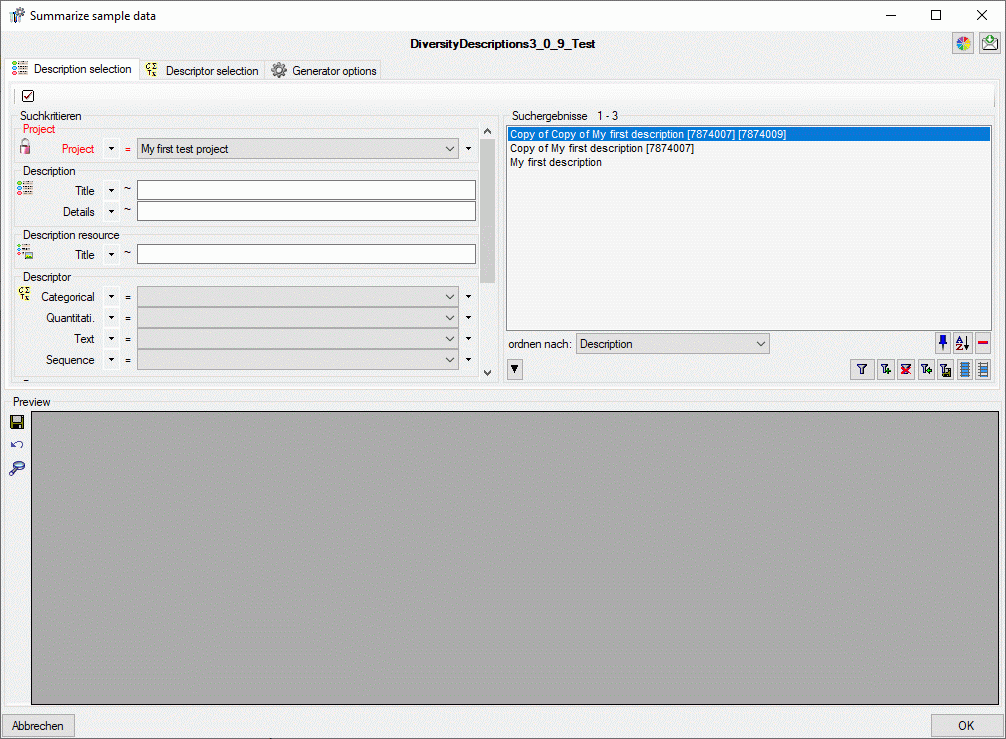
You have to select at least the mandatory parameter Project and
start a query with button  . From the result list
superfluous entries may be removed with the
. From the result list
superfluous entries may be removed with the  button. For a detailled description of the query control please refer to
section Query.
button. For a detailled description of the query control please refer to
section Query.
Descriptor selection
In tab Descriptor selection select the descriptors that shall be
summarized in table column OK (see image below). You can select rsp.
deselect all descriptors with buttons  and
and
 . Button
. Button  inverts
all selections. To select all categorical, quantitative, text or
sequence descriptors the buttons
inverts
all selections. To select all categorical, quantitative, text or
sequence descriptors the buttons  ,
,
 ,
,  and
and
 are avaiable. With button
are avaiable. With button
 you may select a descriptor tree rsp.
descriptor tree node to select all descriptors assigned to the selected
element.
you may select a descriptor tree rsp.
descriptor tree node to select all descriptors assigned to the selected
element.
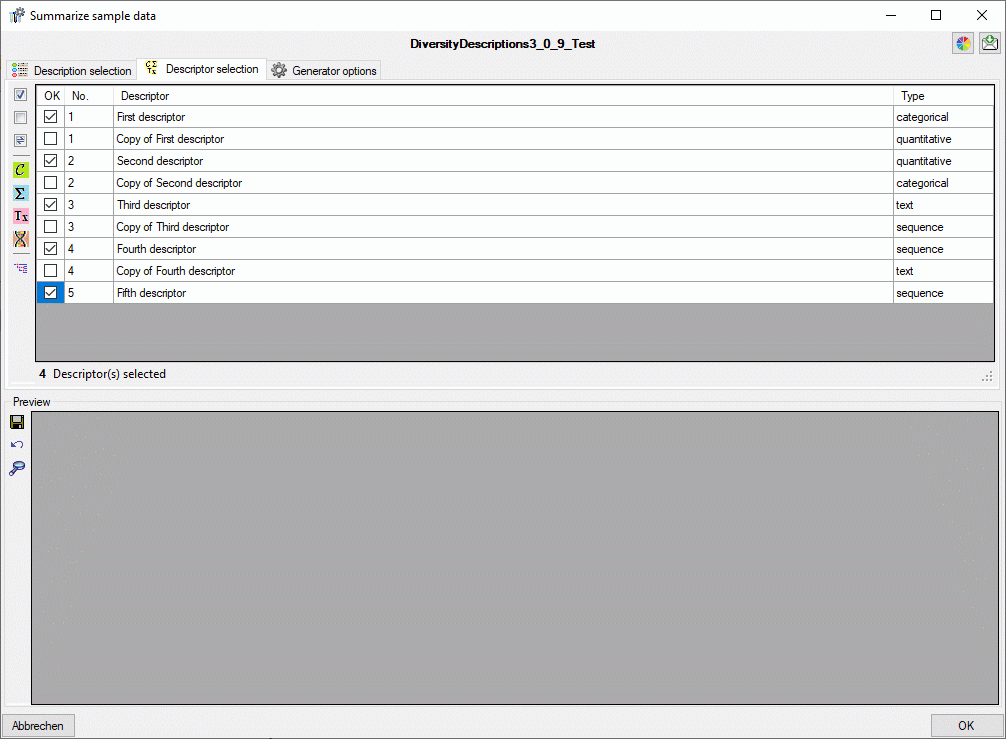
Generator options
In section Summarize options you may specify to Ignore notes and
to Ignore modfier values of the description’s sample data. If you
select Restrict exclusive descriptors, the most often selected
categorical state of a “exclusive” descriptor will be set instead of
accumulating all source values. Accumulate scopes will collect all
scope values of the sampling events (geographic areas) and sampling
units (specimen) in the description summary. Write item count will
enter notes containing information about the number of collected items
in the summary data. If you additionally select Write detailled
notes, the source description IDs will be listed in the notes.
Finally, Write summary infomation inserts a summary about summarized
sampling events into the target description details (see image below).
In section Descriptions and sampling events you find the
descriptions from the query result list in tab Description selection
and their sampling events. You may exclude single sampling events or
even the whole description form the summarization. In the latter case
the description data will not be changed.
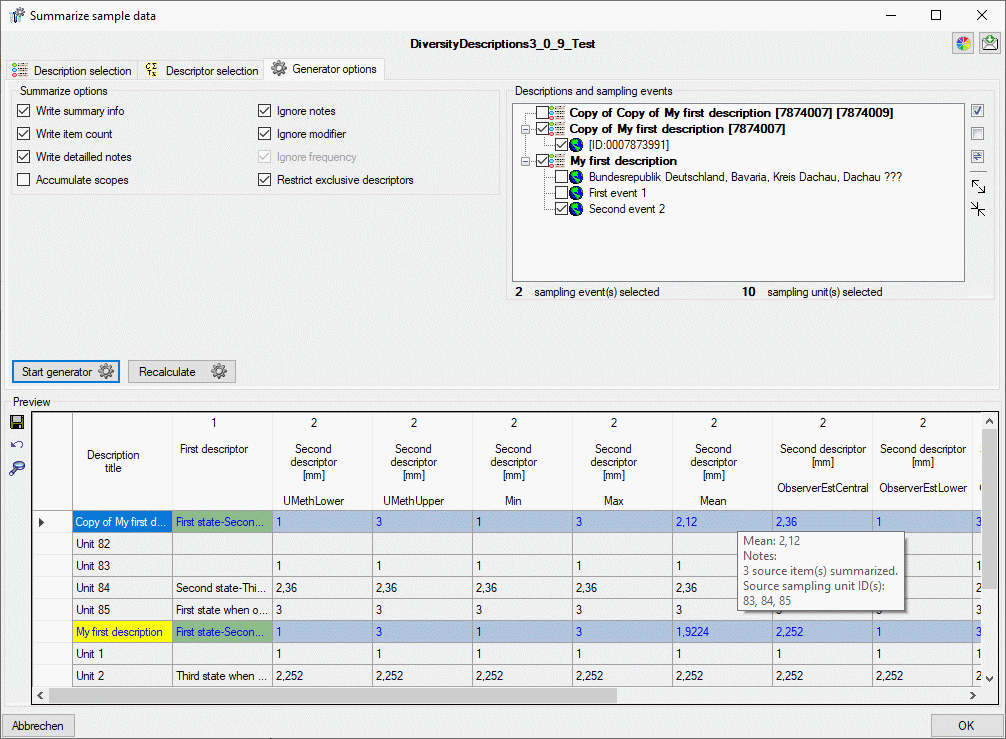
After checking the settings click in button Start generator
 . During processing the icon of the
button changes to
. During processing the icon of the
button changes to  and you may abort by clicking the
button. In the Preview area a table with the updated target
descriptions (coloured background, may be change with button
and you may abort by clicking the
button. In the Preview area a table with the updated target
descriptions (coloured background, may be change with button
 ) and the summarized sampling units (grey
background) is shown. If the target description has been modified, this
is indicated ba a yellow background of the
description title (see image above). Updated values are shown as blue text. By double-clicking on a field in the
preview table you may view the contents in a separate browser window. To
save the updated values and close the window click the OK button. To
exit without saving click Abort. In this case you will be asked if
you want to save modified data.
) and the summarized sampling units (grey
background) is shown. If the target description has been modified, this
is indicated ba a yellow background of the
description title (see image above). Updated values are shown as blue text. By double-clicking on a field in the
preview table you may view the contents in a separate browser window. To
save the updated values and close the window click the OK button. To
exit without saving click Abort. In this case you will be asked if
you want to save modified data.
Since building the preview table may take some time, especially if a lot
of descriptors have been selected, you may use the button Recalculate
 for restarting the summary process. In
this case the descriptor columns will not be re-built, only the summary
data will be calculated and actualized. This feature may be useful, if
you change some settings an want to update the data. If you use the
Recalculate
for restarting the summary process. In
this case the descriptor columns will not be re-built, only the summary
data will be calculated and actualized. This feature may be useful, if
you change some settings an want to update the data. If you use the
Recalculate  button with an empty
preview table, only the description titles will be displayed. Anyway you
can view the summarized data using the
button with an empty
preview table, only the description titles will be displayed. Anyway you
can view the summarized data using the  button (see
below).
button (see
below).
You may store all changed entries by clicking the  button or omit all changes and reload the data by clicking the
button or omit all changes and reload the data by clicking the
 button. To view the description details of the
currently selected entry click the
button. To view the description details of the
currently selected entry click the  button and a
separate browser window opens (see image below).
button and a
separate browser window opens (see image below).
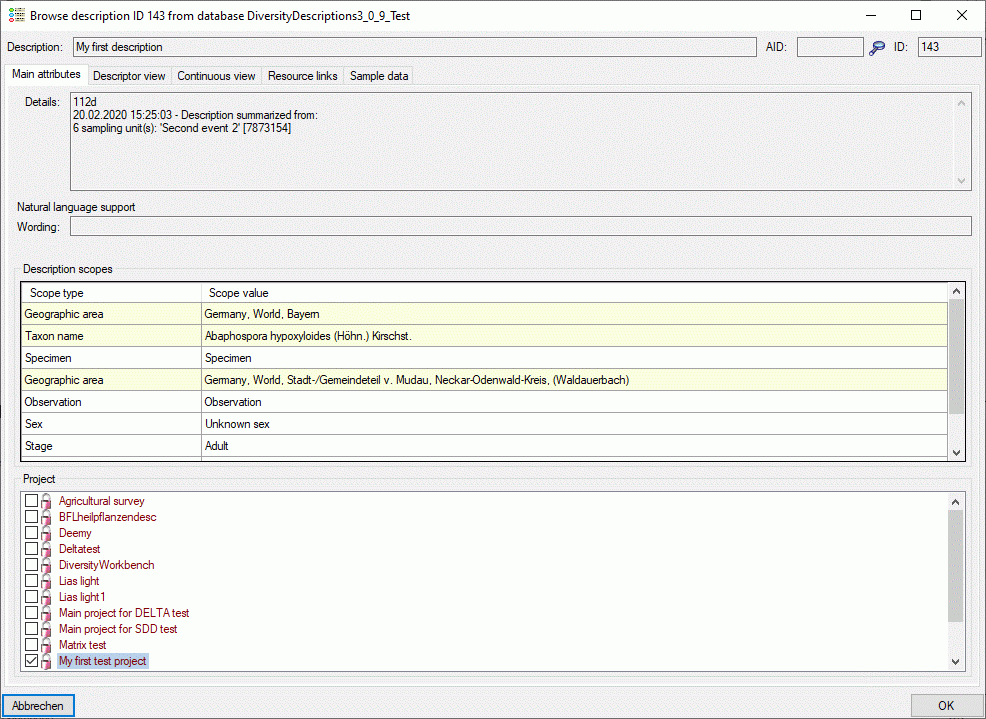
 Summarize
descriptions : Summarize the data of
selected descriptions and create a new one or update an existing
description.
Summarize
descriptions : Summarize the data of
selected descriptions and create a new one or update an existing
description. Summarize sample
data : Summarize the sample data of
selected descriptions and update their summary data.
Summarize sample
data : Summarize the sample data of
selected descriptions and update their summary data.

 Database ->
Database ->


 . From the result list
superfluous entries may be removed with the
. From the result list
superfluous entries may be removed with the  button. For a detailled description of the query control please refer to
section
button. For a detailled description of the query control please refer to
section  and
and
 . Button
. Button  inverts
all selections. To select all categorical, quantitative, text or
sequence descriptors the buttons
inverts
all selections. To select all categorical, quantitative, text or
sequence descriptors the buttons  ,
,
 ,
,  and
and
 are avaiable. With button
are avaiable. With button
 you may select a descriptor tree rsp.
descriptor tree node to select all descriptors assigned to the selected
element.
you may select a descriptor tree rsp.
descriptor tree node to select all descriptors assigned to the selected
element.

 . During processing the icon of the
button changes to
. During processing the icon of the
button changes to  and you may abort by clicking the
button. In the Preview area a table with the generated rsp. updated
target description (coloured background, may be change with button
and you may abort by clicking the
button. In the Preview area a table with the generated rsp. updated
target description (coloured background, may be change with button
 ) and the summarized source descriptions (grey
background) is shown. If the target description has been modified, this
is indicated ba a
) and the summarized source descriptions (grey
background) is shown. If the target description has been modified, this
is indicated ba a  button (see
below).
button (see
below). button or omit all changes and reload the data by clicking the
button or omit all changes and reload the data by clicking the
 button. To view the description details of the
currently selected entry click the
button. To view the description details of the
currently selected entry click the 



